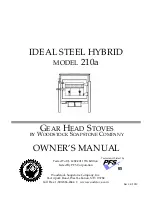
studs, possibly resulting in a fire. As waves of radiant heat energy meet a combustible object,
heat is absorbed and the temperature of the object is raised, which can result in spontaneous
combustion. Similarly, wood-framed walls which are covered with tile, stone or fire-rated
sheetrock must be considered combustible. Fire-rated sheetrock is also considered combustible
due to the paper covering.
If you wish to install your stove closer to a combustible wall than standard clearances will per-
mit, you can either attach an approved stove & pipe shield, or mount a ventilated, non-com-
bustible shield on the wall.
Stove and Pipe Shields:
Clearances can be reduced by attaching an approved heat shield, part #IS-256 and pipe
shield, part #W-413. Woodstock Soapstone Company carries heat shields specifically designed
for this stove. When using one or both of these shields,
clearance is measured from the back of
the shield to the combustible wall
. The clearance behind the stove can be reduced to 6 inches.
The clearance behind the pipe can be reduced to 6 inches.
Clearance Table:
The Ideal Steel Stove can be installed at a 14” clearance with no additional protection, if the stove pipe is top vented,
and the provided shield, is used to cover the rear flue cover plate. To further reduce the rear clearance to 6”, you must
attach an approved rear heat shield and a 36” pipe shield.
*
These clearance reductions meet or exceed requirements of NFPA 211, Standard for Chimneys, Fireplaces, Vents, and Solid Fuel
Burning Appliances. Approved NFPA 211 clearance reduction methods
DO NOT
allow stove clearances to be reduced below 12”.
NFPA WALL SHIELDS MUST BE SIZED TO NFPA 211 SPECIFICATIONS. CONSULT NFPA 211 AND A QUALIFIED EXPERT
BEFORE IMPLEMENTING THESE REDUCTIONS.
The only approved method allowing for a rear stove clearance less than 12” is the Approved Rear Heat Shield (#IS-256) provided by
Woodstock Soapstone Co. If your installation requires the use of the Approved Rear Heat Shield call 1-800-866-4344.
• These clearances apply to walls, ceilings, furniture and other combustibles.
• The 36” Vertical Stack Shield attaches to the back of the stove pipe and prevents excess heat from being radiated from the pipe.
Heat shield protection is only required for the first 36” of vertical connector pipe.
• At least 30” is required from the front of the stove to combustibles (such as curtains, wall hangings, and furniture).
The same clearances from your stove and stove pipe apply to both fireplace and freestanding installations. Be
particularly careful to check clearances to a wood mantel or a wood fireplace facade. You must maintain a 30” clearance
to an unprotected wood mantel. See Fireplace Installations on Page 5.
Clearance Table For Model 210 IDEAL STEEL
Type of Installation
Top Vent
Rear Vent Rear Vent with elbow
Stove Sides
Stoveck
Pipe goes
Type of protection
Stove Back Stovepipe
No Protection
14”
14”
23”
15”
19”
With 36” Pipe Shield
14”
6”
19”
With Approved Rear Heat Shield
6”
14”
6”
*
19”
(Part #IS-256) and 36” Pipe Shield
3
1
/
2
” thick Masonry Against
12”
12”
20”
12”
13”
Combustible Wall
*
3
1
/
2
” thick Masonry with
12”
12”
14”
6”
12”
1” ventilated airspace
*
24 ga. sheet metal with
12”
12”
14”
6”
12”
1” ventilated airspace
*
1/2” thick non-combustible
12”
12”
14”
6”
12”
insulation board with 1” airspace
*
Clearance from
stove back, top
vent, with
stove pipe
which goes
straight up
Clearance
from stove
back and pipe,
which goes
straight back
Clearance from stove back
and vertical single wall
connector pipe
with elbow at stove back
8
Rear heat shield & pipe
shield reduce required
rear clearance to 6”
See note below regarding NFPA
211 clearance reduction methods
and implementation.
See note below regarding NFPA
211 clearance reduction methods
and implementation.
See note below regarding NFPA
211 clearance reduction methods
and implementation.
See note below regarding NFPA
211 clearance reduction methods
and implementation.
*
Controlling clearance













































